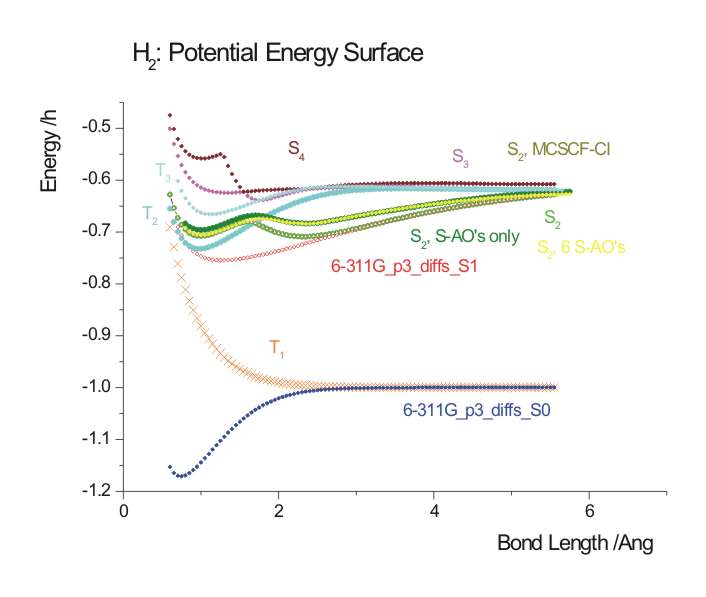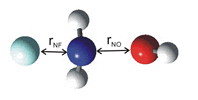
| Startseite |
Unter einer Potenzialkurve versteht man die Abhängigkeit der Gesamtenergie (TOTAL ENERGY) von den Kernkoordinaten (Abstand, Winkel).
Beispiel: H2 in verschiedenen elektronischen Zuständen

Am bequemsten erstellt man eine Potenzialkurve mit RUNTYP=SURFACE und $SURF
!
! H2-Molekuel, Surface, R=0.74A
!
$CONTRL SCFTYP=RHF MULT=1 RUNTYP=SURFACE COORD=ZMT $END
$SYSTEM TIMLIM=1000 MEMORY=5000000 $END
$BASIS GBASIS=STO NGAUSS=6 $END
$SURF IVEC1(1)=2,1 ORIG1=0.0 DISP1=0.1 NDISP1=3 IGRP1=1 $END
$GUESS GUESS=HUCKEL $END
$DATA
H2-Molekuel, CI
DNH 2
H
H 1 rHH
rHH=0.37
$END
RUNTYP=SURFACE: Scan einer Energiehyperfläche, hier eindimensional d.h.
Potentialkurve
$SURF: IVEC1(1)=2,1: Vektor des Atoms 1 bezüglich des Bindungsabstandes
zwischen 2 und 1.
ORIG1=0.0: Startwert für die Bindungslänge;
DISP1=0.1: step
size;
NDISP1=3: number of steps;
IGRP1=1: an array specifying a group of atoms,
which must include the second atom in IVEC1, relative to the first atom given in
IVEC1.
! EXAM29. surface scan
! The scan is done over a 3x3 grid centered on the SCF
! transition state for the SN2 type reaction
! F- + NH2OH -> F-NH2-OH anion -> FNH2 + OH-
!
! Groups 1 and 2 are F and OH, and their distance from
! the N is varied antisymmetrically, which is more or
! less what the IRC should be like. The results seem to
! indicate that the MP2/3-21G saddle point would shift
! further into the product channel, since the higher
! MP2 energies occur at shorter r(NF) and longer r(NO):
!
! FINAL E= -229.0368324609, E(MP2)= -229.3873302369
! FINAL E= -229.0356378404, E(MP2)= -229.3866642674
! FINAL E= -229.0309266309, E(MP2)= -229.3822094766
! FINAL E= -229.0372146681, E(MP2)= -229.3923234053
! FINAL E= -229.0385440291, E(MP2)= -229.3936486639
! FINAL E= -229.0367369550, E(MP2)= -229.3913683060
! FINAL E= -229.0328601143, E(MP2)= -229.3918932008
! FINAL E= -229.0364643928, E(MP2)= -229.3948325495
! FINAL E= -229.0372478241, E(MP2)= -229.3943498134
!
! A more conclusive way to tell this would be to compute
! single point MP2 energies along the SCF IRC, since the
! true reaction path always curves, and thus does not lie
! along rectangular grid points.
!
$contrl scftyp=rhf runtyp=surface icharg=-1 coord=zmt
mplevl=2
$end
$system memory=500000 timlim=30 $end
$surf ivec1(1)=2,1 igrp1(1)=1 ivec2(1)=2,5 igrp2(1)=5,6
disp1= 0.10 ndisp1=3 orig1=-0.10
disp2=-0.10 ndisp2=3
orig2= 0.10
$end
$basis gbasis=n21 ngauss=3 $end
$guess guess=huckel $end
$data
F-NH2-OH exchange (inspired by J.Phys.Chem. 1994,98,7942-4)
Cs
F
N 1 rNF
H 2 rNH 1 aFNH
H 2 rNH 1 aFNH 3 aHNH +1
O 2 rNO 3 aONH 4 aONH -1
H 5 rOH 2 aHON 1 180.0
rNF=1.7125469
rNH=0.9966981
rNO=1.9359887
rOH=0.9828978
aFNH=90.18493
aONH=79.34339
aHON=100.78851
aHNH=108.57000
$end
 |
rNF: Abstand N-F rNO: Abstand N-O |
ivec1(1)=2,1; ivec2(1)=2,5 bezieht sich auf die obigen Abstände. Der
Klammerausdruck ist notwendig. Die Zahl in der Klammer gibt offensichtlich an,
dass es sich um Array 1 handelt.
igrp1(1)=1; igrp2(1)=5,6: der erste Ausdruck funktioniert auch als igrp1=1. Hier
werden offensichtlich die Molekülteile beschrieben, die sich als Ganzes
bewegen. Die NH2-Gruppe bleibt fest; variiert wird zum einen der
Abstand des F-Atoms und zum anderen die OH-Gruppe.
Winkel können mit dieser Methode nicht variiert werden.
| Seitenanfang |